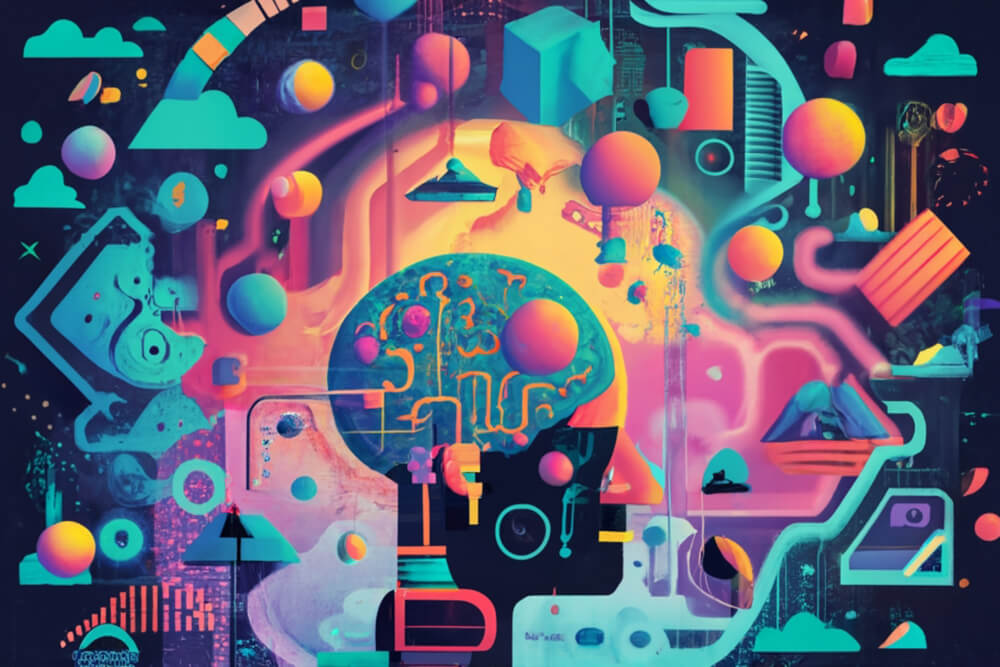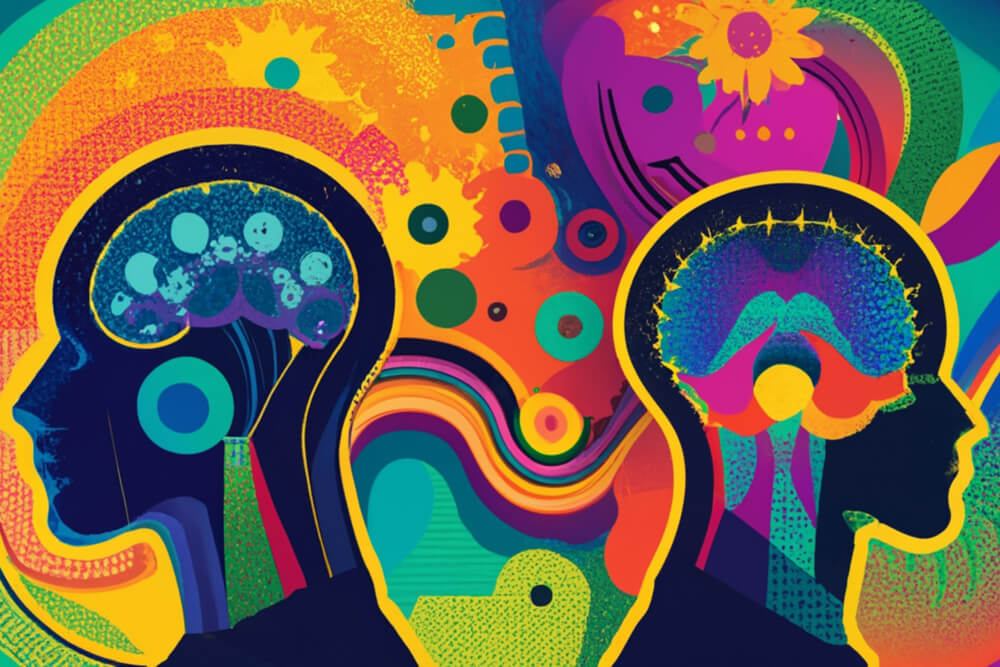The Role of Brain Entropy, Hierarchical Predictive Processing, and Insight
Canalization, a term often used when describing evolutionary processes, is also relevant regarding psychopathology. In this context, canalization can be thought of as the process by which a person develops maladaptive patterns of thinking, feeling, and behaving. These patterns can be reinforced by repeated exposure to negative experiences, and they can become increasingly difficult to change over time.
Psychedelics have been shown to have the potential to disrupt canalization in psychopathology. This is because psychedelics can increase brain entropy, which is a measure of the disorderliness or randomness of brain activity. Increased brain entropy can lead to a de-weighting of canalized habits, which means that these habits become less dominant and more easily changed.

Unpacking the Mechanisms of Canalization in Cognitive and Behavioral Contexts
The brain is a remarkable organ, capable of constructing intricate models of the external world. These models, born out of a combination of genetics, past experiences, and real-time sensory data, serve as frameworks for understanding reality. By creating these predictive structures, the brain aims to minimize uncertainty and optimize adaptive behaviors. This modeling is a part of a broader neurocognitive strategy often termed ‘predictive coding,’ a mechanism through which the brain anticipates future events to inform present-moment actions and thoughts.
The Double-Edged Sword of Predictive Models
While predictive models are highly advantageous for survival—enabling rapid responses to potential threats and efficient problem-solving—they come with a downside. In some cases, these models become excessively rigid or hyper-precise. Rather than serving as flexible frameworks that adapt to new data, they become almost like cognitive traps, reinforcing the same thought patterns, emotional responses, and behaviors regardless of the contextual appropriateness or factual validity.

The Slippery Slope Towards Maladaptive Patterns
Once a predictive model becomes rigid, it’s as if a groove has been etched deeply into the neural landscape—a pathway that thoughts and actions readily follow. This is the core of what is meant by canalization in a psychological setting. These entrenched patterns often become self-reinforcing through a feedback loop. Maladaptive behaviors lead to negative outcomes, which then serve to confirm the initial rigid model, thereby strengthening the canalization.
Illustrating the Dangers
Consider the example of an individual who has suffered abuse. Through repeated negative interactions with their abuser, their brain constructs a model that categorizes all human interaction as potentially dangerous. While this model might serve as an effective short-term strategy for avoiding further abuse from the specific perpetrator, it becomes problematic when generalized to all people. The individual may become socially withdrawn and isolated, driven by the deeply canalized belief that social engagement is fraught with danger. This can result in a cascade of further issues, including loneliness, heightened stress responses, and exacerbation of mental health conditions.
Nuanced Factors Contributing to Canalization
It’s important to note that canalization doesn’t occur in isolation. Other factors like genetic predispositions, social reinforcements, and even epigenetic changes can contribute to the robustness of these entrenched patterns. This multi-layered causality makes canalization particularly challenging to disrupt.
How Can Psychedelics Disrupt Canalization?
The term ‘entropy’ in a neurological context refers to the unpredictability or randomness in a system—in this case, the brain. Brain entropy measures the level of complexity in neural network activities, encapsulating how much various regions of the brain communicate with each other and how dynamic this communication is. Research shows that higher brain entropy correlates with greater cognitive flexibility and a broader range of potential mental states.
The Biochemical Dynamics Underlying Increased Entropy
Psychedelics like LSD, psilocybin, and DMT work primarily by interacting with the serotonin 5-HT2A receptor. The activation of these receptors leads to a cascade of neurochemical changes that affect various neurotransmitter systems and brain regions. These alterations disrupt the usual patterns of neurotransmission and neural connectivity, contributing to increased brain entropy.

Dissolving the Boundaries of Canalized Habits
With the elevation of brain entropy during a psychedelic experience, entrenched patterns of thought and behavior—what have been termed ‘canalized habits’—start to lose their grip. High entropy states force the brain to venture outside its typical operational pathways. The neural networks get ‘shuffled,’ making it less likely for the brain to rely solely on existing predictive models. This provides an opportunity for the de-weighting or even dismantling of maladaptive canalized patterns, as the brain is pushed to create new, more flexible models that can adapt to a wider range of experiences and information.
The Importance of Set and Setting
It should be noted that the disruption of canalization through psychedelics is significantly influenced by ‘set’ (mindset) and ‘setting’ (environment). The context in which the psychedelic is consumed can have a profound impact on the experience and its long-term effects. In a therapeutic setting, guided by skilled facilitators or mental health professionals, the increased entropy has the potential to be channeled into constructive paths, facilitating the restructuring of maladaptive patterns.
The Role of Hierarchical Predictive Processing
Hierarchical predictive processing (HPP) is a theory of brain function that proposes that the brain is constantly trying to predict the future. This prediction is done by creating a hierarchy of models, each of which makes predictions about the next level down.
Canalized habits are thought to be created by the brain when it develops a model of the world that is too precise or rigid. This model is unable to account for the variability of the real world, and it leads to the development of maladaptive patterns of behavior.
When a person takes a psychedelic, it can disrupt the brain’s ability to make predictions. This can lead to a de-weighting of canalized habits, as the brain is forced to create new models that are more flexible and adaptable.
Engaging with Hierarchical Predictive Processing
The use of psychedelics also interacts with the brain’s hierarchical predictive processing systems. By disturbing the established hierarchy of models used for prediction, psychedelics can allow for more ‘bottom-up’ information to flow through the cognitive hierarchy. This results in a more comprehensive reassessment of established beliefs and behaviors, offering a broader canvas on which to paint new, adaptive models.
The “Empty Center” of Canalized Habits
The idea that canalized habits have an “empty center” is based on the concept of HPP. According to HPP, all models are ultimately inaccurate, and they are constantly being updated based on new information. However, some models are more accurate than others, and they can become more dominant over time.
Canalized habits are thought to be created by the brain when it develops a model of the world that is too precise or rigid. This model is unable to account for the variability of the real world, and it leads to the development of maladaptive patterns of behavior.
When a person takes a psychedelic, it can disrupt the brain’s ability to make predictions. This can lead to a de-weighting of canalized habits, as the brain is forced to create new models that are more flexible and adaptable.
The realization that a canalized habit has an “empty center” can be a liberating experience. This is because it means that the habit is not necessary, and it can be changed. This insight can be accompanied by a feeling of relief, as the person is no longer bound by the habit.
The Potential for Treatment
The concept of canalization in psychopathology is a complex one, but it is an important concept to understand if we are to develop effective treatments for mental health conditions. Psychedelics have the potential to disrupt canalization, and this could lead to new and innovative treatments for a variety of mental health disorders.
For example, psychedelics have been shown to be effective in treating anxiety disorders, depression, and post-traumatic stress disorder. These disorders are often characterized by the development of maladaptive patterns of thinking, feeling, and behaving. Psychedelics can help to disrupt these patterns by increasing brain entropy and de-weighting canalized habits.
Conclusion
The research on the potential of psychedelics to disrupt canalization in psychopathology is still in its early stages, but the results so far are promising. More research is needed to fully understand how psychedelics work and to develop safe and effective treatments for mental health conditions.
However, the potential benefits of psychedelics are great, and they could revolutionize the way we treat mental health disorders. By disrupting canalization, psychedelics could help people to break free from the maladaptive patterns that are holding them back. This could lead to a new era of mental health care that is more effective and more humane.






4 Responses
These articles by Tyler are very informative and helpful in understanding how the psilocybin experience can be therapeutic in regards to mental health issues. It’s reassuring to see that Eleusinia has this kind of focus which is of particular interest to me. Looking forward to the visit
Have psychedelics been studied as treatment for psychosis or disorders such as schizophrenia?
Yes. Research on psychedelics has touched on their potential relation to psychosis and disorders such as schizophrenia. In some studies psychedelics gave been shown to resemble some core symptoms of schizophrenia due to their high affinity for serotonin 5-HT(2A) receptors, which is also targeted by psylocybin-like drugs. This suggests a possible overlap in the neurochemical abnormalities between psychedelics and schizophrenia. Historically, psychedelics were used to model psychosis for research purposes. It was believe that psychedelics caused symptoms similar to those found in patients living with psychosis and schizophrenia. There are concerns about treating schizophrenia patients with psychedelic drugs due to the potential induction or exacerbation of psychosis. However, strategies could be implemented to mitigate these risks. Psychedelics have helped us to understand the role of 5-HT receptors in the pathogenesis of the disorder. There’s an overlap between schizophrenia and psychedelic-induced states both biologically and clinically. Additionally, before the ban on psychedelics, there were attempts to treat schizophrenia with these substances, however the results of those studies were inconclusive. More Recently findings on receptor, signaling, and circuit mechanisms underlying the response to psychedelic and antipsychotic drugs might lead to a unification of the serotonin and glutamate neurochemical hypotheses of schizophrenia. Overall, the data suggest a complex relationship between psychedelics, psychosis, and schizophrenia. The resemblance in neurochemical abnormalities and symptoms, historical usage of psychedelics to model psychosis, and concerns in utilizing psychedelics for treatment present a nuanced scenario. While there’s a potential for psychedelics to aid in understanding and possibly treating schizophrenia, caution due to the risk of exacerbating psychosis is warranted.
Interesting read. Thank you.